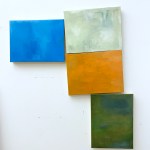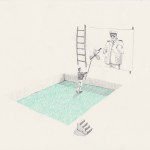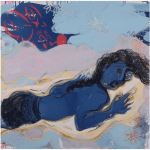Contributed by Jonathan Goodman / Ann Schaumburger is a disciplined and systematic painter. She uses basic geometric motifs (triangle, rectangle, and square) to develop permutations of a core set of four brilliant colors that elaborate the intuitive resonance of a single structure: the gabled roof house. Works recently on view at A.I.R. Gallery draw on miners stone houses in Cornwall, England, and prefabricated metal sheds in Amherst, Virginia. The idea of a home, however schematic, evokes real-world associations, establishing a rich and subtle balance between form and content.
Tag: Jonathan Goodman
Devra Fox’s eccentric realism
Contributed by Jonathan Goodman / Devra Foxs thirteen graphite drawings on view at Hesse Flatow in Chelsea, two blue and the rest gray, depict structures organic in presentation but with an eerie resemblance to manmade objects such as furniture.
Alan Prazniak’s kaleidoscopic view
Contributed by Jonathan Goodman / Alan Prazniak’s small paintings, on view at Geary Contemporary in NYC and Millerton, align with one another, offering a kaleidoscopic account of open meadows and grasslands, perhaps informed by early memories.
Stacy Lynn Waddell: Moving backwards to jump ahead
Contributed by Jonathan Goodman / In �Mettle,� Stacy Lynn Waddell�s expansive show at Candice Madey, the artist embraces different cultures throughout the world: Malian life in the 1960s; nineteenth-century American painting reflecting burgeoning capitalism; and seventeenth-century Dutch flower painting.
Caroline Kent: A set of symbols
Contributed by Jonathan Goodman / Caroline Kent, a painter based in Chicago, is having her first show at Casey Kaplan. She makes schematic abstract paintings, which have aspects of doubled, mirror-like imagery. An underlying fiction of her art is the presence of twins, Victoria and Veronica, who speak to each other and to the painter�s audience via the works she creates. Kent�s sign-like abstraction involves a set of symbols whose meaning depends not on any explicitly prescribed content but rather on their visual orientation in terms of form and placement.


















